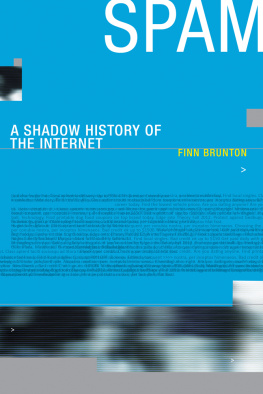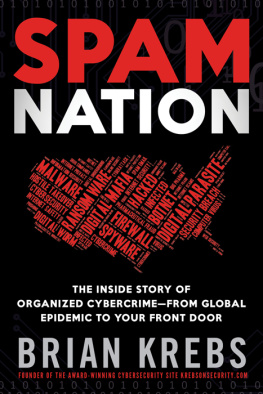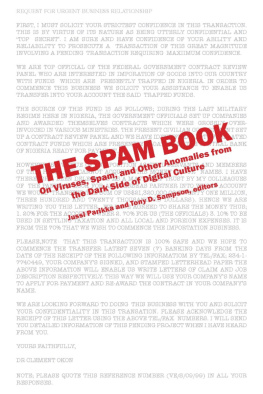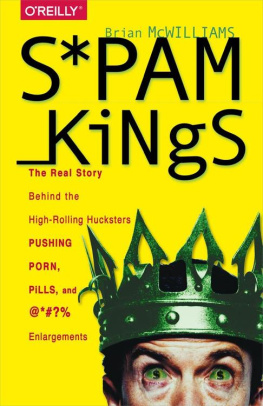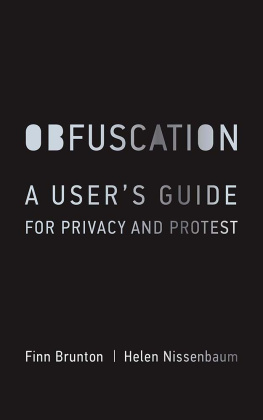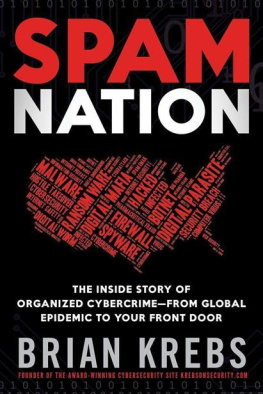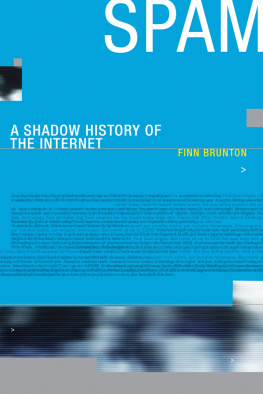Spam
Infrastructures Series
edited by Geoffrey Bowker and Paul N. Edwards
Paul N. Edwards, A Vast Machine: Computer Models, Climate Data, and the Politics of Global Warming
Lawrence M. Busch, Standards: Recipes for Reality
Lisa Gitelman, ed., Raw Data Is an Oxymoron
Finn Brunton, Spam: A Shadow History of the Internet
Nil Disco and Eda Kranakis, eds., Cosmopolitan Commons: Sharing Resources and Risks across Borders
Spam
A Shadow History of the Internet
Finn Brunton
The MIT Press
Cambridge, Massachusetts
London, England
2013 Massachusetts Institute of Technology
All rights reserved. No part of this book may be reproduced in any form by any electronic or mechanical means (including photocopying, recording, or information storage and retrieval) without permission in writing from the publisher.
Library of Congress Cataloging-in-Publication Data
Brunton, Finn, 1980
Spam : a shadow history of the Internet / Finn Brunton.
p. cm.(Infrastructures)
Includes bibliographical references and index.
ISBN 978-0-262-01887-6 (hardcover : alk. paper)
ISBN 978-0-262-31395-7 (retail e-book)
1. Spam (Electronic mail)History. I. Title.
HE7553.B78 2013
384.34dc23
2012034252
10 9 8 7 6 5 4 3 2 1
This book is dedicated to the memory of Gunard Solberg, dear friend and inspiration, deeply missed.
Acknowledgments
This book owes its start as a dissertation to Christopher Fynsk and Mario Biagioli. Without their advice, encouragement, feedback, provocations, and patience, it would never have been written. James Leach and Timothy Lenoir were kind enough to sit on my dissertation committee, where they provided excellent comments towards that document eventually becoming this book. Its production would likewise have been impossible without the conversation and support of Helen Nissenbaum while I was at NYU; portions of this book were written at NYU while funded by grants from the National Science Foundation (CNS/NetS 1058333) and the AFSOR-MURI Presidio grant. Paul Edwards, Gabrielle Hecht, and the STS Reading Group at the University of Michigan in Ann Arbor read a full draft of this manuscript and gave a writers dream of thorough, exacting, and unfailingly helpful comments and advice. Finally, this book would not have taken shape without the work of Marguerite Avery, Katie Persons, Kathleen Caruso, Nancy Kotary, Celeste Newbrough, and the reviewers at MIT.
Many of the ideas, examples and conclusions in this book evolved while in conversation with Lucy Alford, C. W. Anderson, Gus Andrews, Burhanuddin Baki, Don Blumenfeld, danah boyd, Mia Sara Bruch, Douglass Carmichael, Michael Cohen, Sande Cohen, Gabriella Coleman, Jean Day and the reviewers at Representations, Charlie DeTar, Alexander Galloway, Kristoffer Gansing, Lisa Gitelman, Matt Gleeson, Sumana Harihareswara, Sean Higgins, Micah Jacob, Ben Kafka, Daniel V. Klein, Jorge Ledo, Joanne McNeil, Ben Marsden, Jay Murphy, Kathryn Myronuk, Quinn Norton, Camille Paloque-Bergs, Jussi Parikka, Leonard Richardson, Nora Roberts, Erica Robles, Tony Sampson, Luke Simcoe, Fred Turner, and a number of people who would like to remain anonymous. Thanks so much to you all. Any mistakes are, of course, my own.
Introduction: The Shadow History of the Internet
Prelude: The Global Spam Machine
Pitcairn Island in the South Pacific is the smallest and least populated jurisdiction in the world, described by the first mariner to observe it as a great rock rising out of the sea... about a thousand leagues westward to the continent of America. Its a lonely place; when the Bounty mutineers needed a refuge from the global empire whose laws theyd broken, they sailed for Pitcairn and vanished for almost two decades. As of last years electoral rolls, there are 45 people on Pitcairn, most of them descended from the mutineers. There is a government-subsidized satellite Internet connection for the islands houses. Per capita, Pitcairn Island is the worlds number-one source of spam.
How is this possible? Can this island, whose major export industries are handicrafts for passing ships and stamps for philatelists, host a cabal of spammers bombarding the world with phishing messages and Viagra ads by satellite connection? In the list of spam production per capita, Pitcairn is followed by Niue and Tokelau, also in the South Pacific; the Principality of Monaco, whose population overwhelmingly consists of rich expatriates dodging taxes in the worlds second smallest country; and the Principality of Andorra, a country one-fifth the size of Rhode Island. Are there really that many Catalan-speaking Andorran spam barons, accumulating stolen credit card data by the ski slopes of the Pyrenees?
The answer is no, of course. The Polynesians who live on Niue, like the wealthy Europeans overlooking the Mediterranean, have been unknowingly conscripted into the business of spam. Virtually all of us on the Internet have been, on one side or another. Spam has changed laws and communities at the points of friction where the networks capacities rub against prior orders of work and governance. It has changed our language, economics, and culture and exerted a profound effect on our technologies. It has subtlyand not so subtlydeformed the shape of life online, pulling it into new arrangements that make no more sense than the movement of the galaxies unless you allow for the mass of all the dark matter. Only at scale, in time and in space, can we begin to bring this shape into focus. It stretches from embryonic computer networks in the 1960s and 1970s to the global social graph of 2010, from the basements of MIT to the cybercafs of Lagos, Rotterdam, and Tallinn. It encompasses points across the network from covert chat channels to Googles server farms to ghost number blocks to anonymous banks of airport pay phones. The spam most of us experience every day as a minor and inexplicable irritant is like the lonely rock that sailor sighted, merely the visible peak of vast and submerged infrastructures with much to say about the networked world.
The word spam means very different things to different people at different times. It is a noun, collective and singular, as this spam can mean all these messages Ive received or this particular email. It is a verb, as in they spam me, and an adjective, as in this is spammy. It refers to many varieties of exploitation, malfeasance, and bad behavior, and spam terminology has branched out into specific subdomains, from phishing spam and 419 spam to splogs, linkfarms, floodbots, content farms. (All of these new terms and forms will be defined and described in the following chapters.) It can easily slide into what philosophers call the sorites paradox (sorites, appropriately for talking about spam, comes from the Greek word for heap or pile) to describe the linguistic confusion between grains of sand and sand in dunes, the moment at which individual bits become a single big pile. When spam is discussed in journalism or casual conversation, the word is often meant as I have used it in the previous paragraph, as a unified substance or a continuous event, like smog or a mass or pulp, as Susanna Paasonen puts it. But spam begins to make sense only when we get specific and separate out the different types, motives, actors, and groups.
Spam is not a force of nature but the product of particular populations distributed through all the worlds countries: programmers, con artists, cops, lawyers, bots and their botmasters, scientists, pill merchants, social media entrepreneurs, marketers, hackers, identity thieves, sysadmins, victims, pornographers, do-it-yourself vigilantes, government officials, and stock touts. Long as it is, this list mentions only those who live there more or less full-time, because everyone online participates in the system of spam, however indirectly. We fund and enable it with choices we make and trade-offs we are willing to accept because the benefits to the network outweigh the costs. We generate areas of relevance and attention whose discovery and exploitation is the heart of the business. We alter how spam works and break up its current order with choices, refusals, and purchases whose consequences we may not understand.
Next page
